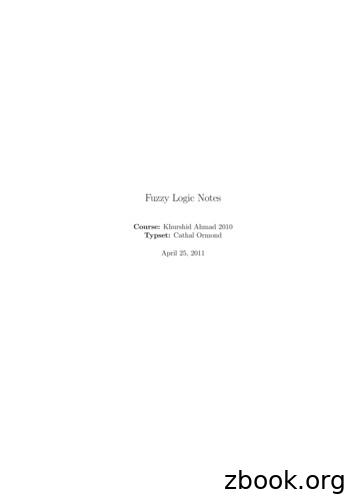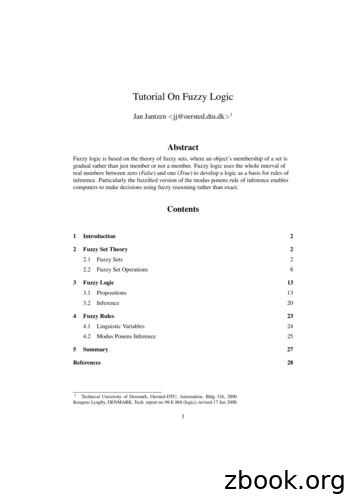Introduction To Fuzzy Logic
Introduction toFuzzy LogicIJCAI2018Tutorial1
Crisp set vs. Fuzzy setA traditional crisp setA fuzzy set2
Crisp set vs. Fuzzy set3
Crisp Logic Example I Crisp logic is concerned with absolutes-true or false,there is no in-between. Example:Rule:If the temperature is higher than 80F, it is hot; otherwise, it isnot hot.Cases:Temperature 100FHotTemperature 80.1FHotTemperature 79.9FNot hotTemperature 50FNot hot––––4
Crisp Logic Example I cont.Membership function of crisp logicTrue1HOTFalse080FTemperatureIf temperature 80F, it is hot (1 or true);If temperature 80F, it is not hot (0 or false).5
Example II : Crisp set1015ft 11ins7ft heightA crisp way of modellingtallness05ft 11ins7ft heightA crisp version of short6
Example II : Crisp set1tallquite tall0very tall5ft 11ins7ftheightcrisp definitions for tallness7
Example II : Fuzzy set10height8
Example II : Fuzzy set105ft 11ins7 ftheightA possible fuzzy set tall9
Example II : Fuzzy set105ft 11ins7 ftheightA possible fuzzy set short10
Example II : Fuzzy set1tallshort0.750.4005ft 11ins7 ftheightMembership functions thatrepresent tallness and short11
Fuzzy Sets Fuzzy sets is fully defined by its membershipfunctions. Membership function is a function in [0,1]that represents the degree of belonging.Fuzzy valuesDOMDegree ofMembership 1YoungMiddleOld0.50254055Age12
Some maths!Formal definitions of a fuzzy set For any fuzzy set, (let’s say) A, the function µArepresents the membership function for which µA(x)indicates the degree of membership that x, of theuniversal set X, belongs to set A and is, usually,expressed as a number between 0 and 1µA(x) : X [0,1] Fuzzy sets can be either discrete or continuous13
The notation for fuzzy sets: for the member, x, ofa discrete set with membership µ, we use thenotation µ/x . In other words, x is a member ofthe set to degree µ. Discrete sets are defined as:A µ1 /x1 µ2/x2 . µn/xn or (in a more compact form)x1 ,x2 , . xn : members of the set Aµ1, µ2, .µn : x1 , x2 . xn ’s degree of membership.14
A continuous fuzzy set A can be defined as:µExample:Discrete andContinuousfuzzy sets torepresent the setof numbers“close to 1”numbers15
Example: describing people as “young”, “middle-aged”,and “old”µ1Middle-agedyoungold0Age Fuzzy Logic allows modelling of linguistic terms usinglinguistic variables and linguistic values. The fuzzy sets“young”, “middle-aged”, and “old” are fully defined bytheir membership functions. The linguistic variable “Age”can then take linguistic values.16
Key Points for a fuzzy set:– The members of a fuzzy set are members to somedegree, known as a membership grade or degree ofmembership– A fuzzy set is fully determined by the membershipfunction– The membership grade is the degree of belongingto the fuzzy set. The larger the number (in [0,1]) themore the degree of belonging.– The translation from x to µA(x) is known asfuzzification– A fuzzy set is either continuous or discrete.– Fuzzy sets are NOT probabilities– Graphical representation of membership functionsis very useful.17
Fuzzy Sets18
Fuzzy Sets – definition19
Membership Degree20
Fuzzy Sets Representation I21
Fuzzy Sets Representation II22
Example of Membership Functions23
Unimodal Functions24
Singletons25
Classical Set Function26
Linear Functions27
Triangular Functions28
Triangular Functions29
Trapezoidal Functions30
Trapezoidal Functions31
Support of Fuzzy Sets32
Empty Fuzzy SetAn empty fuzzy set has an empty support33
Compact Support34
Alpha-cuts Sets35
Level Set36
Resolution Principle37
Cardinality38
Cardinality – cont.39
Height of a fuzzy set40
Fuzzy subsets41
Equal Fuzzy Sets42
Fuzzy Membership Functions One of the key issues in all fuzzy sets is how todetermine fuzzy membership functions The membership function fully defines the fuzzy set A membership function provides a measure of thedegree of similarity of an element to a fuzzy set Membership functions can take any form, but thereare some common examples that appear in realapplications43
Membership functions can– either be chosen by the user arbitrarily, based onthe user’s experience (MF chosen by two userscould be different depending upon theirexperiences, perspectives, etc.)– Or be designed using machine learning methods(e.g., artificial neural networks, geneticalgorithms, etc.) There are different shapes of membershipfunctions; triangular, trapezoidal, piecewiselinear, Gaussian, bell-shaped, etc.44
Fuzzy Operations(Fuzzy Union, Intersection, and Complement) Fuzzy logic begins by borrowing notions from crisp logic, just asfuzzy set theory borrows from crisp set theory. As in our extensionof crisp set theory to fuzzy set theory, our extension of crisp logic tofuzzy logic is made by replacing membership functions of crisplogic with fuzzy membership functions [J.M. Mendel, Uncertain RuleBased Fuzzy Logic Systems, 2001] In Fuzzy Logic, intersection, union and complement are defined interms of their membership functions This section concentrates on providing enough of a theoretical basefor you to be able to implement computer systems that use fuzzylogic Fuzzy intersection and union correspond to ‘AND’ and ‘OR’,respectively, in classic/crisp/Boolean logic These two operators will become important later as they are thebuilding blocks for us to be able to compute with fuzzy if-then rules45
Classic/Crisp/Boolean Logic Logical AND ( ) Logical OR (U)Truth TableA0011B0101A B0001ABCrisp IntersectionA0011Truth TableBAUB00110111ABCrisp Union46
Fuzzy Union The union (OR) is calculated using t-conorms t-conorm operator is a function s(.,.) Its features are––––s(1,1) 1, s(a,0) s(0,a) a (boundary)s(a,b) s(c,d) if a c and b d (monotonicity)s(a,b) s(b,a) (commutativity)s(a,s(b,c)) s(s(a,b),c) (associativity) The most commonly used method for fuzzy union is totake the maximum. That is, given two fuzzy sets A and Bwith membership functions µA(x) and µB(x)µ AUB ( x) max(µ A ( x), µ B ( x))47
Fuzzy Intersection The intersection (AND) is calculated using t-norms. t-norm operator is a function t(.,.) Its features––––t(0,0) 0, t(a,1) t(1,a) a (boundary)t(a,b) t(c,d) if a c and b d (monotonicity)t(a,b) t(b,a) (commutativity)t(a, t(b,c)) t(t(a,b),c) (associativity) The most commonly adopted t-norm is the minimum.That is, given two fuzzy sets A and B with membershipfunctions µA(x) and µB(x)µ AÇB ( x) min(µ A ( x), µ B ( x))48
Fuzzy Complement To be able to develop fuzzy systems we also haveto deal with NOT or complement. This is the same in fuzzy logic as for Booleanlogic For a fuzzy set A, A denotes the fuzzycomplement of A Membership function for fuzzy complement isµ ( x) 1 - µ A ( x)A49
Product of Two Fuzzy Sets50
Sum of Two Fuzzy Sets51
Linguistics Hedges and Operators A fuzzy set can be regarded as corresponding to a linguistic value suchas “tall”, and a linguistic variable “height” can be regarded as rangingover such linguistic values. One powerful aspect of fuzzy sets in this context is the ability to dealwith linguistic quantifiers or “hedges”. Hedges such as more or “less”, “very”, “not very”, “slightly” etccorrespond to modifications in the membership function of the fuzzy setinvolved. The fuzzy set operations such CON, DIL, INT etc (see the table ofhedges and Operators) can be used to modify the fuzzy set.52
Hedges and Operators53
Fuzzy Logic IJCAI2018 Tutorial 1. Crisp set vs. Fuzzy set A traditional crisp set A fuzzy set 2. . A possible fuzzy set short 10. Example II : Fuzzy set 0 1 5ft 11ins 7 ft height . Fuzzy logic begins by borrowing notions from crisp logic, just as
2.2 Fuzzy Logic Fuzzy Logic is a form of multi-valued logic derived from fuzzy set theory to deal with reasoning that is approximate rather than precise. Fuzzy logic is not a vague logic system, but a system of logic for dealing with vague concepts. As in fuzzy set theory the set membership values can range (inclusively) between 0 and 1, in
ing fuzzy sets, fuzzy logic, and fuzzy inference. Fuzzy rules play a key role in representing expert control/modeling knowledge and experience and in linking the input variables of fuzzy controllers/models to output variable (or variables). Two major types of fuzzy rules exist, namely, Mamdani fuzzy rules and Takagi-Sugeno (TS, for short) fuzzy .
fuzzy controller that uses an adaptive neuro-fuzzy inference system. Fuzzy Inference system (FIS) is a popular computing framework and is based on the concept of fuzzy set theories, fuzzy if and then rules, and fuzzy reasoning. 1.2 LITERATURE REVIEW: Implementation of fuzzy logic technology for the development of sophisticated
Fuzzy logic versus neural networks The idea of fuzzy logic is to approxi-mate human decision-making using nat-ural-language terms instead of quantita-tive terms. Fuzzy logic is similar to neur-al networks, and one can create behav-ioral systems with both methodologies. A good example is the use of fuzzy logic for automatic control: a set of .
A Short Fuzzy Logic Tutorial April 8, 2010 The purpose of this tutorial is to give a brief information about fuzzy logic systems. The tutorial is prepared based on the studies [2] and [1]. For further information on fuzzy logic, the reader is directed to these studies. A fuzzy logic system (FLS) can be de ned as the nonlinear mapping of an
Tutorial On Fuzzy Logic Jan Jantzen 1 Abstract Fuzzy logic is based on the theory of fuzzy sets, where an object’s membership of a set is gradual rather than just member or not a member. Fuzzy logic uses the whole interval of real numbers between zero (False) and one (True) to develop a logic as a basis for rules of inference.
Fuzzy logic has two different meanings. In a narrow sense, fuzzy logic is a logical system, which is an extension of multivalued logic. However, in a wider sense fuzzy logic (FL) is almost synonymous with the theory of fuzzy sets, a theory which relates to classes of objects with unsharp boundaries in which membership is a matter of degree. In .
The Roundtable API procedure is deployed as source and is located in /rtb/p/rtb_api.p. Complete details on using the API can be found in the definitions section of the API procedure. 3.2 Example – Creating a Task 3.2.1 Initializing the API In its most basic form, initializing the API is just a matter running the API procedure























